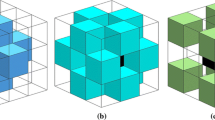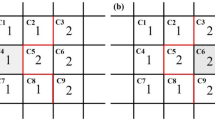Abstract
A new extended technique for 3D modelling of normal grain growth in low carbon steels is presented in this paper. This technique is based on real-valued cellular automata with the use of a local transition function that allows it to be applied to materials with both fcc and bcc lattices with the grain growth being easily simulated in ferrite as well as in austenite cases. The simulated data were calibrated with four sets of experimental data for isothermal grain coarsening in austenite, alpha- and delta-ferrites. The obtained results cogently demonstrate that there is a good agreement between simulated and experimental data across a wide range of temperatures. The new model developed in this paper, allows for the identification of two different mechanisms of grain growth in austenite. It is also shown in this paper that the newly presented approach can be used to extract additional parameters from the grain growth process, such as grain boundary velocity, mobility and driving force, which are hardly accessible even via real-time experiments.









Similar content being viewed by others
References
Hallberg H (2011) Metals 1:16. doi:10.3390/met1010016
Janssens KGF (2010) Math Comput Simul 80:1361. doi:10.1016/j.matcom.2009.02.011
Xu X, Mahfouf M, Banks SP, Zhang Q (2011) The european congress and exhibition on advanced materials and processes (Euromat). Montpellier, France
Raabe D (2002) Annu Rev Mater Res 32:53. doi:10.1146/annurev.matsci.32.090601.152855
Raabe D, Hantcherli L (2005) Comput Mater Sci 34:299. doi:10.1016/j.commatsci.2004.12.067
Zheng C, Raabe D, Li D (2012) Acta Mater 60:4768
D Raabe, RC Becker (2000) Model Simul Mater Sci Eng 8. doi:10.1088/0965-0393/8/4/304
Raabe D (1999) Philos Mag A 79:2339. doi:10.1080/01418619908214288
Wang C, Liu G, Wang G, Xue W (2007) Mat Sci Eng A Struct 454–455:547. doi:10.1016/j.msea.2006.12.013
Wejrzanowski T, Batorski K, Kurzydłowski KJ (2006) Mater Charact 56:336. doi:10.1016/j.matchar.2005.09.010
Humphreys J, Hatherly M (2004) Recrystallization and related annealing phenomena, 2nd edn. Elsevier, Oxford
Ding HL, He YZ, Liu LF, Ding WJ (2006) J Cryst Growth 293:489. doi:10.1016/j.jcrysgro.2006.05.060
Wolfram S (2002) A new kind of science. Wolfram Media, IL
Rollett AD, Raabe D (2001) Comput Mater Sci 21:69
Raabe D (2000) Acta Mater 48:1617
Hu H, Rath BB (1970) Metall Trans 1:3181
Gleiter H (1969) Acta Metall Mater 17:853
Haessner F (1975) J Phys-Paris 36:345. doi:10.1051/jphyscol:1975435
Liu Y, Baudin T, Penelle R (1996) Scripta Mater 34:1679
Hu H (1974) Can Metall Quart 13:275
Moon J, Lee J, Lee C (2007) Mat Sci Eng A Struct 459:40. doi:10.1016/j.msea.2006.12.073
Zhou T, O’malley RJ, Zurob HS (2010) Metall Mater Trans A 41:2112. doi:10.1007/s11661-010-0246-y
W Yu (2002) Cellular automata modelling of austenite grain coarsening during reheating. PhD thesis. The University of Sheffield, p 183
Beck PA, Kremer JC, Dewer LJ, Holzworth ML (1948) Trans AIMME 175:372
Vandermeer RA, Hu H (1994) Acta Metall Mater 42:3071
Rabkin E (1999) Interface Sci 7:297
Erb U, Gleiter H (1979) Scripta Metall Mater 13:61. doi:10.1016/0036-9748(79)90390-9
Zheng L, Yuan Z-x, Song S-h, Xi T-h, Wang Q (2012) J Iron Steel Res Int 19:73. doi:10.1016/s1006-706x(12)60063-6
Simpson CJ, Aust KT (1972) Surf Sci 31:479
Acknowledgements
The authors wish to acknowledge the UK-Engineering and Physical Sciences Research Council (UK-EPSRC) for their financial support under Grant No. EP/F023464/1. The authors would also like to thank Professor A. Howe (Tata Steel), Dr C. Pinna, Dr Y. Lan, and Professor P. Tsakiropoulos for their helpful comments during the course of this research work. Finally, they wish to thank the Editor and the anonymous reviewers for their comments which helped to improve the quality of this paper.
Author information
Authors and Affiliations
Corresponding author
Additional information
This work was performed while the first author worked at the University of Sheffield.
Rights and permissions
About this article
Cite this article
Vertyagina, Y., Mahfouf, M. & Xu, X. 3D modelling of ferrite and austenite grain coarsening using real-valued cellular automata based on transition function. J Mater Sci 48, 5517–5527 (2013). https://doi.org/10.1007/s10853-013-7346-1
Received:
Accepted:
Published:
Issue Date:
DOI: https://doi.org/10.1007/s10853-013-7346-1




